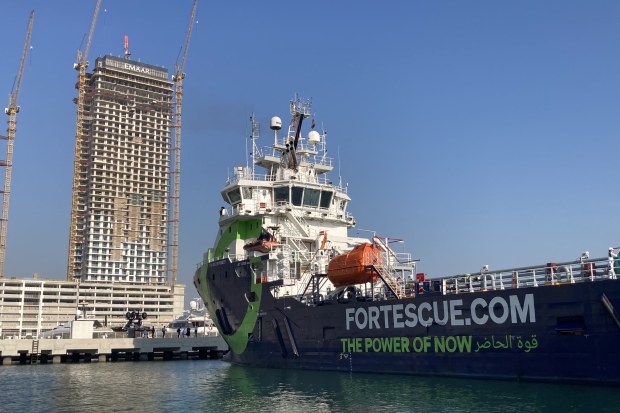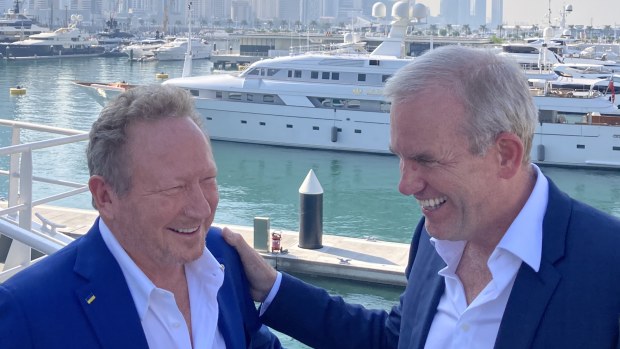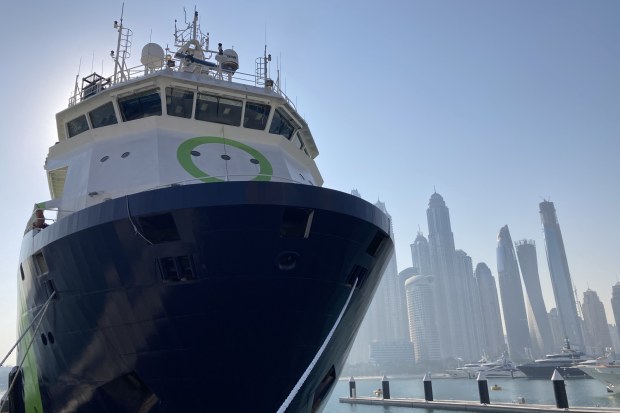Forrest’s green ship makes a splash in Dubai

Dubai | At Dubai Harbour marina, amid the sleek luxury of the locals’ super yachts, bobs an incongruous interloper: a large, workmanlike commercial vessel – too small to be a freighter, but dwarfing the nearby millionaires’ playthings.
This one belongs to a billionaire. The identity of the owner is immediately obvious from the green circle logo painted on the front and sides, and the name: the Fortescue Green Pioneer.

The Fortescue Green Pioneer is decorated in classic Forrest fashion. Hans van Leeuwen
When Andrew Forrest attends an international summit, be it a COP climate jamboree, a Davos or a United Nations General Assembly, a nifty publicity stunt is inevitably part of the package. A fleet of green London taxis before COP26 in Glasgow; a hydrogen car at Davos; a drone display over the UN building in New York this year.
For COP28, the Green Pioneer weighed anchor at its usual berth in Singapore and made for Dubai. The ammonia-powered vessel is the prototype for Dr Forrest’s plan to make Fortescue Metals Group’s fleet of iron ore freighters carbon-free – and he wanted to show off the art of the possible.
But there was just one catch: under today’s maritime rules, a ship powered by ammonia is not allowed to berth at any port. So it chugged into Dubai on a traditional diet of dirty bunker fuel.
That was all the incentive Dr Forrest needed for one of his trademark bursts of colourful fury. He wants to be green, but instead he’s seeing red.
“If it was powered by fuels which are going to destroy this planet, destroy the future of your own children – diesel, bunker sea oil – then it’s ‘come on in, the water’s fine!’,” he said. “‘Oh, no, a pollution-free ship? Stop right there, don’t come in!’”
He told a story of being at one of California’s ports and being informed by the authorities that his ship would not be welcome, prompting him to make an appeal to the governor, who knocked heads together.
“The governor said, ‘That’s not good enough – if Dr Forrest wants to bring in a pollution-free ship into the Port of Los Angeles, I want it in, I want it in straightaway’. That’s the type of pressure which will come on, when solutions are available and people don’t act.”

Fortescue Metals chairman Andrew Forrest with Fortescue Future Industries CEO Mark Hutchinson. Hans van Leeuwen
On the technological front, Dr Forrest and the CEO of Fortescue Future Industries, Mark Hutchinson, predict that they will launch a 300-metre, 270,000-tonne iron ore freighter fuelled by ammonia “this decade”. As Mr Hutchinson pointed out, the FMG-owned boats are a Scope 2 emission: “it’s not optional, we have to do it”.
But the International Maritime Organisation and the ports needed to play ball, Dr Forrest said. “We will start calling out ports and regulated authorities, if we don’t see really positive action within the next four months,” he vowed.
The federal government’s climate change ambassador, Kristin Tilley, was on hand to welcome the boat to Dubai, and hailed it as “demonstration and evidence of what’s possible now”.
“Fifteen years ago, it was a fantasy, it was someone else’s problem. Today we’re seeing vision and demonstration. In 15 years, that will be very clear delivery, progress, and near-achievement of what we’re aiming for,” she said.
“When I think about what government does, and the sort of meetings and discussions we sit in at the COPs, they’re in closed meeting rooms, no windows, talking about words, talking about plans. That stuff is really important, it’s what government does, but it’s nothing if we don’t actually see the evidence and the delivery, that we do here today.”

The bow of the ammonia-powered Fortescue prototype, berthed in Dubai. Hans van Leeuwen
Mr Hutchinson said the prototype had cost “tens of millions of dollars” to get onto the water – a decent sum of money, but that’s partly the purpose of the $6 billion that FFI has been given to decarbonise the business.
“We did the same thing on the trucks and the trains. You build a prototype first, see if it works, doesn’t work. You try it again. This is our prototype. This is part of the capex we will spend on the decarbonisation of the ships.”
Many large shippers, such as Maersk, are punting on green methanol to get their emissions down – at least in the short to medium term. But neither Mr Hutchinson nor Dr Forrest were buying that.
With green methanol, “you’ve still got to release the CO2. So at the end of the day, even if it’s bio, you’re still releasing emissions into the atmosphere”, Mr Hutchinson said.
Dr Forrest, as always, was more forthright: “E-methanol is like sustainable aviation fuel, it’s not a solution. We need massive-scale energy for huge shipping, huge heavy industry. It’s not going to come out of competing with a food source,” he said.
“It’s not going to happen. I mean, it’ll happen for greenwashing. But it won’t happen as a real solution. Real solutions are industrial: industrial-scale ammonia production, industrial-scale consumption, zero pollution.”
Introducing your Newsfeed
Follow the topics, people and companies that matter to you.
Find out moreRead More
Latest In Energy & climate
Fetching latest articles